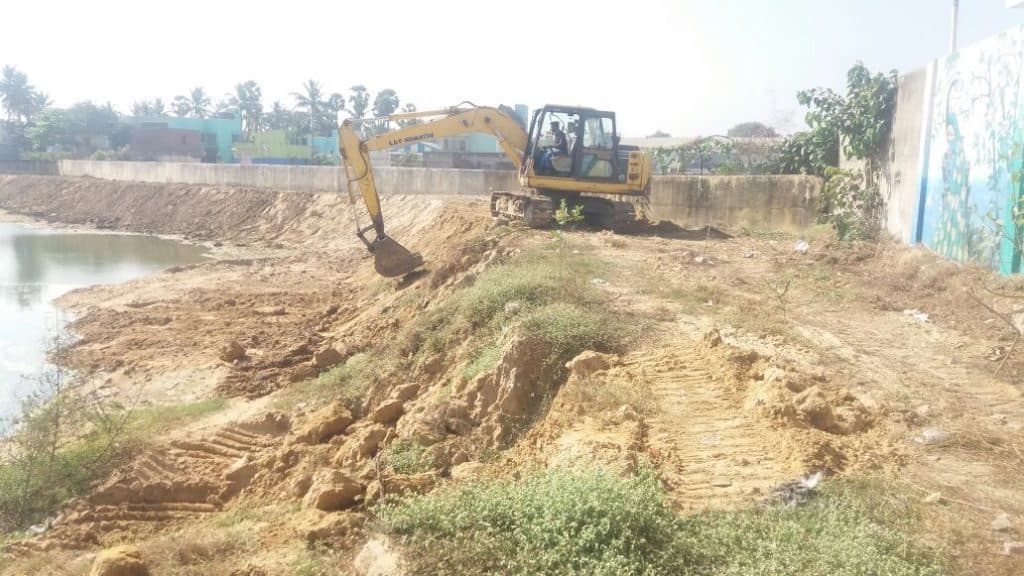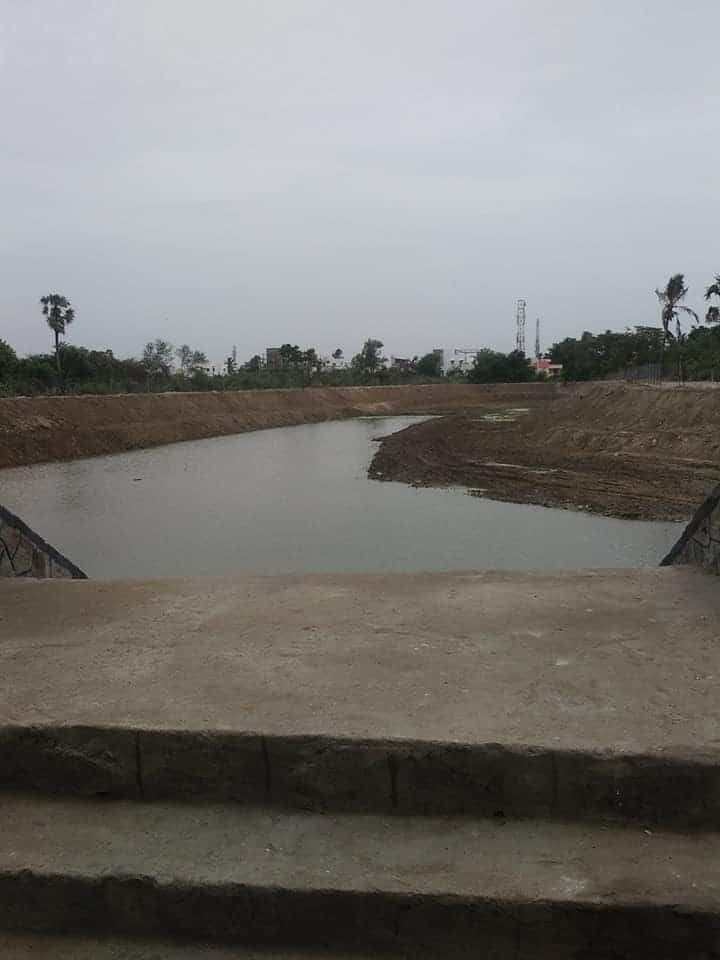Every Chennaiite who has lived through the floods of 2015 has a quiet apprehension about the monsoon. The revelation that the 2015 flooding, which left scores dead and Chennai in shambles, was the result of inaction on the part of officials, has increased the distrust among the public. However, a joint effort by various stakeholders to renew and restore close to a 100 water bodies under the Greater Chennai Corporation has been underway for many months now.
The Goals of Restoration
Flood mitigation, renewal of water table and rejuvenation of water bodies constitute the aim of the initiative that has seen civic authorities, companies, non-profit organizations and subject matter experts come together. Water bodies around the city will see a new lease of life before the upcoming monsoon. The initiative will effectively prevent, or at the very least ameliorate any flood situation, if the possibility arises.

Consolidating bunds which had got eroded in the previous monsoon, at Omakulam. Pic: Chennai City Connect
“The Greater Chennai Corporation has on record 210 water bodies under its control across the city. We have been working with various corporate organizations on their CSR activities, as well as with several NGOs, to identify and restore them. Some of these water bodies are under an acre while others are bigger. The aim is to complete the effort in a few months, right in time for the monsoon,” said Bala of Chennai City Connect, an NGO involved in the initiative.
Extensive field surveys, mapping and planning has gone into the restoration efforts. The water bodies were first mapped across the city with the help of officials from the Chennai Corporation. On completion, various organisations expressed interest in taking up the restoration efforts. Environment Foundation of India, Rotary Club of Madras and Confederation of Indian Industry are a few of the organisations that have come forward to steer the rejuvenation of Chennai’s water bodies.
Community involvement
The Confederation of Indian Industry has adopted a total of 31 water bodies, mainly in Zones 14 and 15. The first of the water bodies has been restored and handed back to the community. The Gangaiamman Koil Kulam restoration was completed a couple of weeks ago, and the community is set to play an active role in its upkeep.
Simeon Joshua, a senior associate at CII, was part of the extensive effort. Speaking about the process, he said, “The restoration posed some challenges, given the encroachment and internal politics in the area. But we were able to complete the effort as the community came forward to aid us. One of our key focus areas is getting the community involved and handing the water body back to them. To this end a committee has been formed with members from the area who will be in charge of its maintenance.”
Joshua adds that lack of data is an issue as they turn towards the other water bodies. “With no information on the size and depth of these, we have had to hire a private surveyor for assessment and cross-check with any documents available.”
The restoration of water bodies is a crucial component of flood mitigation measures, and the coming together of various stakeholders, and community involvement in particular is a positive sign of things to come.
“A lot of work has gone into this over many months and we hope that this will help during the monsoons. Quite a few organisations have expressed interest in being a part of it. The authorities have also been proactive. While the work is ongoing in some water bodies, some others are awaiting approval from the authorities. The larger water bodies such as Villivakkam lake and the many temple ponds in the city are also up for restoration” said Raj Cherubal, CEO of Chennai Smart City Limited.
A multi-stakeholder effort such as this has its numerous challenges but with active help from authorities and communities, the many water bodies of Chennai are set to be renewed soon. An official from the Chennai Corporation expressed his faith in the efforts, “We have to act fast before the rains. The floods are always at the back of people’s minds.With the undertaking of these restoration initiatives we hope that the fears can be allayed.”
An organisation interested in taking over water bodies for restoration must submit a detailed proposal to the Deputy Commissioner (Works), Corporation of Chennai. The organisations may bring in their technical expertise or be paired with experts after their proposal is accepted.


Congratulations Chennai.Yes.This is what is required in every city.Water boddies have been gobbled up by land mafia while the local corporation looked the other way.Comparitively Chennai stands out for a definite better Civic sense among its citizens.
First Govt should form more Twitter handles to enabled users easy access to raise issues. That’s a great way where Bangalore has seen huge backlash for pressing issues.
Not enough only the restoration. Please try also to restore the system as a whole on natural flow pattern, that is based on the olden days practices of water harvesting and management that is on a watershed basis IWRM Basis. Otherwise this solo or focused restoration may get into trouble during excess rainfall period that we have witnessed during 2015.